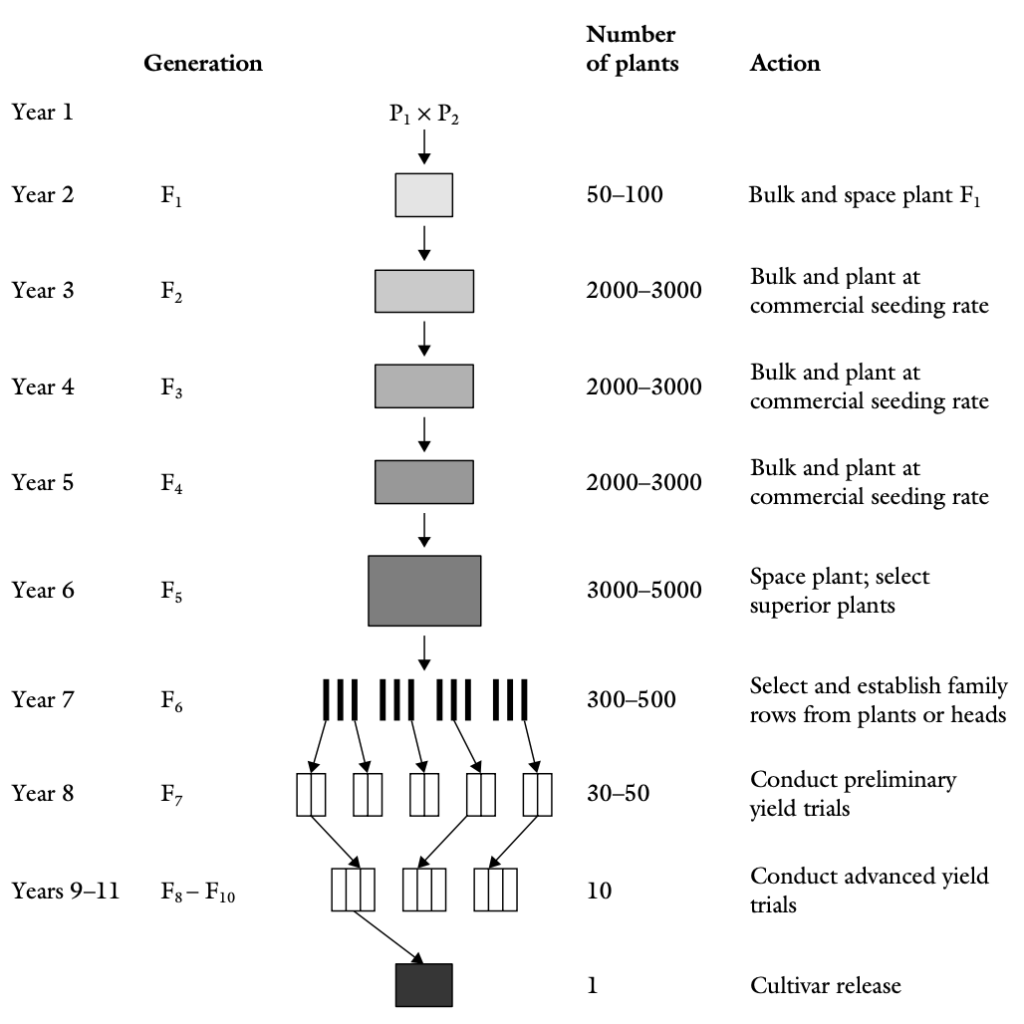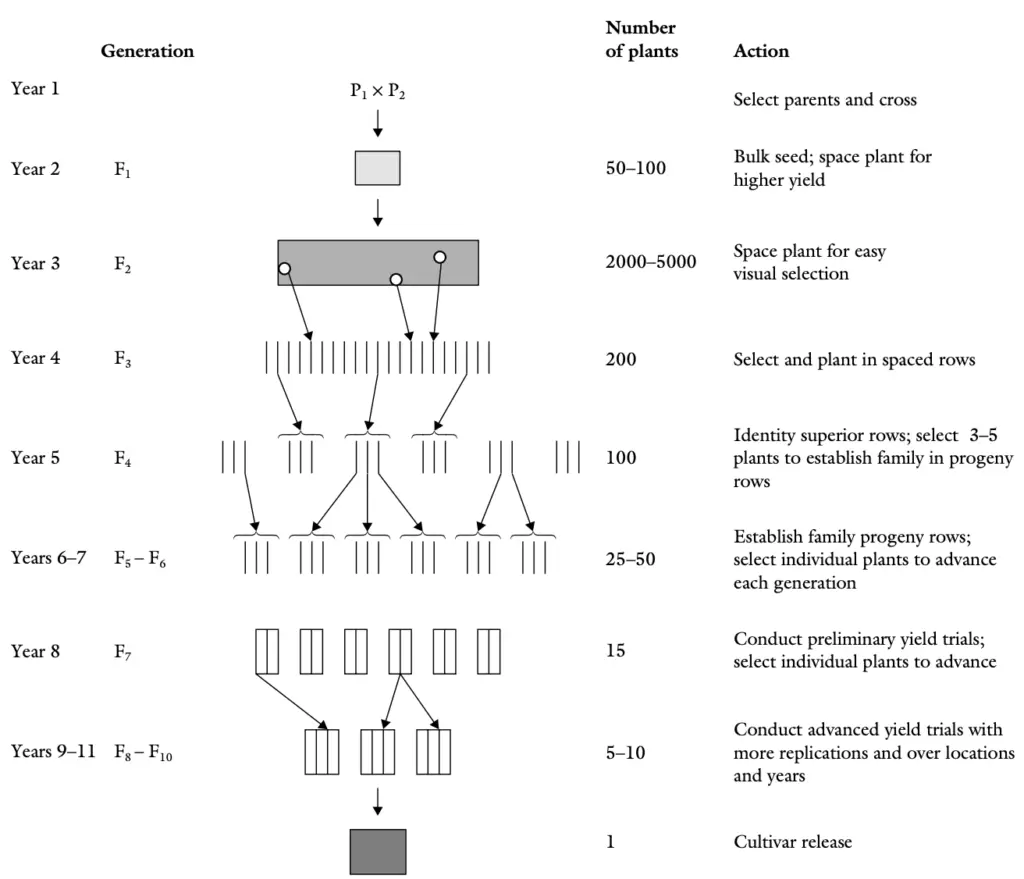What is bulk Method?
The bulk method is a plant breeding technique used to develop new varieties by selecting plants with desirable traits through repeated cycles of selection and propagation. Here’s a brief overview of how it works:
- Initial Selection: A large number of plants are grown from a diverse genetic pool. These plants are usually grown from seed and may be derived from a cross between two different varieties or lines.
- Bulk Cultivation: The selected plants are grown together in bulk, meaning they are not individually maintained but rather grown as a large population. This helps maintain genetic diversity and allows for natural selection to occur.
- Selection and Harvesting: Plants are periodically evaluated for desirable traits. Instead of selecting individual plants, the breeder may select a subset of the population that best exhibits the desired traits. Seeds from these selected plants are harvested and used to grow the next generation.
- Repetition: The process is repeated over several generations. Each time, the breeder selects the best plants and grows them in bulk, gradually increasing the frequency of desirable traits in the population.
- Stabilization: After several generations, the population is usually evaluated for consistency and stability of the desired traits. Once the new variety meets the desired criteria, it can be released for use.
The bulk method is often used in the early stages of breeding programs to quickly evaluate and select for a wide range of traits before more refined selection methods are applied. It’s a way to efficiently handle large populations and harness natural variation.

What is pedigree method?
The pedigree method is a plant breeding technique used to develop new plant varieties by carefully tracking the lineage and selection history of individual plants. Here’s how it generally works:
- Crossing: Two parent plants with desirable traits are crossed to create offspring. The initial cross is made with the goal of combining beneficial traits from both parents.
- Generation and Selection: The offspring (F1 generation) are grown and evaluated. Promising individuals are selected for their desirable traits. These selected plants are then grown to produce the next generation (F2).
- Tracking and Recording: Throughout the breeding process, each plant’s pedigree is meticulously recorded. This means documenting the parentage and any selection decisions made. This record helps in understanding how traits are inherited and allows for better decision-making in future generations.
- Further Selection: In subsequent generations, the selected plants are grown and evaluated again. The breeder continues to select plants with the best traits while maintaining detailed records of their pedigrees. This helps in identifying the genetic contributions of different parent plants and tracking the inheritance of specific traits.
- Stabilization: After several generations of selection and tracking, the breeder aims to stabilize the desired traits within a population. This means that the new variety consistently exhibits the chosen traits when grown.
- Release: Once the new variety is stable and meets the desired criteria for traits such as yield, disease resistance, or quality, it can be released for cultivation.
The pedigree method allows for precise control over the breeding process and helps in understanding the genetic basis of traits. It is particularly useful for breeding complex traits and for maintaining a clear record of the genetic background of new varieties.

Differences between bulk and pedigree methods
The bulk and pedigree methods are distinct approaches to plant breeding, each with unique characteristics and applications. Here is a comparison between the two methods:
Pedigree Method
- Selection Process:
- Individual plants are selected in the F2, F3, and subsequent generations. Progenies from these selected plants are grown and evaluated individually.
- Use of Selection and Disease Management:
- Artificial selection and management of artificial disease epidemics are integral to the pedigree method. These practices are used to enhance the selection process and improve plant qualities.
- Role of Natural Selection:
- Natural selection does not play a role in the pedigree method. The method relies heavily on controlled selections and interventions.
- Pedigree Records:
- Maintaining detailed pedigree records is essential but can be time-consuming and labor-intensive. These records track the lineage and selection history of individual plants.
- Time Required for Development:
- Developing and releasing a new variety using the pedigree method typically takes 14-15 years due to the detailed selection and documentation process.
- Usage:
- The pedigree method is widely used in plant breeding due to its systematic approach and thorough selection process.
- Breeder Involvement:
- The method requires close attention from the breeder from the F2 generation onward, involving frequent individual plant selections and meticulous record-keeping.
- Planting and Population Size:
- The segregating generations are space-planted to allow for individual plant selection, which generally results in a smaller population size.
Bulk Method
- Selection Process:
- In the bulk method, the entire bulk of seeds from selected plants is maintained and grown in subsequent generations without individual plant selection until later generations.
- Use of Selection and Disease Management:
- While artificial selection and disease management are less emphasized, they may be used to assist natural selection. Artificial selection might be essential in some cases.
- Role of Natural Selection:
- Natural selection is a key factor in determining the composition of populations at the end of the bulking period. It helps enhance the frequency of desirable traits.
- Pedigree Records:
- No pedigree records are maintained in the bulk method, reducing the labor and time required for record-keeping.
- Time Required for Development:
- The development and release of a new variety using the bulk method take much longer, often more than 10 years, as the bulk population must be maintained until natural selection has acted effectively.
- Usage:
- The bulk method is used to a limited extent compared to the pedigree method, primarily for specific purposes like studying gene survival and for crops where rapid population development is advantageous.
- Breeder Involvement:
- The method requires less day-to-day attention from the breeder during the bulking period. Selection and record-keeping are less intensive compared to the pedigree method.
- Planting and Population Size:
- Bulk populations are generally planted at commercial planting rates, resulting in larger populations. This approach increases the likelihood of recovering transgressive segregants due to the broader genetic diversity and natural selection.
| Aspect | Pedigree Method | Bulk Method |
|---|---|---|
| Selection Process | Individual plants are selected in F2, F3, and subsequent generations. Progenies are grown and evaluated individually. | Entire bulk of seeds from selected plants is maintained and grown in subsequent generations without individual plant selection until later generations. |
| Use of Selection and Disease Management | Artificial selection and management of artificial disease epidemics are integral to the method. | Artificial selection and disease management may assist natural selection but are less emphasized. Artificial selection might be essential in some cases. |
| Role of Natural Selection | Natural selection does not play a role. Controlled selection is used. | Natural selection plays a key role in determining the population composition at the end of the bulking period. |
| Pedigree Records | Detailed pedigree records are maintained, which are time-consuming and labor-intensive. | No pedigree records are maintained, saving time and effort. |
| Time Required for Development | Typically takes 14-15 years to develop and release a new variety. | Takes longer, often more than 10 years, as bulk populations must be maintained for natural selection to act. |
| Usage | Widely used in plant breeding due to its systematic approach. | Used to a limited extent, primarily for specific purposes such as studying gene survival. |
| Breeder Involvement | Requires close attention from the breeder, with frequent individual plant selections and record-keeping. | Requires less day-to-day attention during the bulking period. Selection and record-keeping are less intensive. |
| Planting and Population Size | Segregating generations are space-planted, resulting in a smaller population size. | Bulk populations are planted at commercial rates, resulting in larger populations. This increases the likelihood of recovering transgressive segregants. |
- Text Highlighting: Select any text in the post content to highlight it
- Text Annotation: Select text and add comments with annotations
- Comment Management: Edit or delete your own comments
- Highlight Management: Remove your own highlights
How to use: Simply select any text in the post content above, and you'll see annotation options. Login here or create an account to get started.